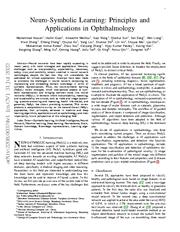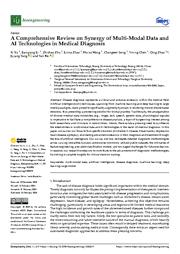A copy of this work was available on the public web and has been preserved in the Wayback Machine. The capture dates from 2019; you can also visit the original URL.
The file type is application/pdf.
Filters
A gene–phenotype relationship extraction pipeline from the biomedical literature using a representation learning approach
2018
Bioinformatics
Combined with abbreviation revision and sentence template extraction, we improved the unsupervised word-embedding-to-sentence-embedding cascaded approach as representation learning to recognize the various ...
Results: We have proposed a pipeline for extracting phenotype, gene and their relations from biomedical literature. ...
Due to the lack of training of positive and negative samples, we use the Negative Class Label Enhanced (NCLE) algorithm (Xing et al., 2017) to label negative samples and train the sentence-embedding ...
doi:10.1093/bioinformatics/bty263
pmid:29950017
pmcid:PMC6022650
fatcat:43lehrpjpfdlblvcbsuvrxebty
Learning for Biomedical Information Extraction: Methodological Review of Recent Advances
[article]
2016
arXiv
pre-print
Unlike existing reviews covering a holistic view on BioIE, this review focuses on mainly recent advances in learning based approaches, by systematically summarizing them into different aspects of methodological ...
Biomedical information extraction (BioIE) is important to many applications, including clinical decision support, integrative biology, and pharmacovigilance, and therefore it has been an active research ...
To overcome cascading errors in a multi-step pipeline framework, joint models (e.g. a Markov Logic Network(MLN) based approach [111] ) have shown improved performance. ...
arXiv:1606.07993v1
fatcat:7d5om7zxxzhoviiriasrfwg3xi
The extraction of complex relationships and their conversion to biological expression language (BEL) overview of the BioCreative VI (2017) BEL track
2019
Database: The Journal of Biological Databases and Curation
provided sentences could be seen. ...
Unfortunately, this knowledge is mostly embedded in the literature in such a way that it is unavailable for automated data analysis procedures. ...
Also our special thanks to Jens Dörpinghaus who kindly helped to create the curation interface. Furthermore, we would like to thank all participants of the BioCreative BEL track. ...
doi:10.1093/database/baz084
pmid:31603193
pmcid:PMC6787548
fatcat:zdc2oacdhfgrdn5gjvkq4jyyzm
Harnessing Explanations: LLM-to-LM Interpreter for Enhanced Text-Attributed Graph Representation Learning
[article]
2024
arXiv
pre-print
Lastly, we believe the versatility of the proposed method extends beyond TAGs and holds the potential to enhance other tasks involving graph-text data. ...
With the advent of powerful large language models (LLMs) such as GPT or Llama2, which demonstrate an ability to reason and to utilize general knowledge, there is a growing need for techniques which combine ...
One approach is to use a cascaded architecture, where the node features are first encoded independently by the LMs, and then fed into GNN models. ...
arXiv:2305.19523v5
fatcat:7vl5s4udabhrbkfictsp5lxtaa
CBAG: Conditional biomedical abstract generation
2021
PLoS ONE
We propose a conditional language model following the transformer architecture. This model uses the "encoder stack" to encode concepts that a user wishes to discuss in the generated text. ...
from the capacity to select the specific set of concepts that underpin a generated biomedical text. ...
tags, and entity class labels associated with each textual element. ...
doi:10.1371/journal.pone.0253905
pmid:34228754
pmcid:PMC8259990
fatcat:xig3mofcaza6tpnda2xircvrxu
De-identification of clinical free text using natural language processing: A systematic review of current approaches
[article]
2023
arXiv
pre-print
Results: A total of 2125 publications were identified for the title and abstract screening. 69 studies were found to be relevant. ...
Machine learning (37 studies) and hybrid (26 studies) approaches are predominant, while six studies relied only on rules. Majority of the approaches were trained and evaluated on public corpora. ...
While some approaches have been trying to extract sentences that do not contain identifiable
information by measuring frequencies of sentences and terms [6], [9], or by creating
representations of clinical ...
arXiv:2312.03736v1
fatcat:gd5oci3z7nbd3bpmvmxt6unbry
PhenoTagger: A Hybrid Method for Phenotype Concept Recognition using Human Phenotype Ontology
2021
Bioinformatics
Next, a cutting-edge deep learning model is trained to classify each candidate phrase (n-gram from input sentence) into a corresponding concept label. ...
Automatic phenotype concept recognition from unstructured text remains a challenging task in biomedical text mining research. ...
Thanks to Chih-Hsuan Wei for his help with Web APIs. Conflict of Interest: none declared. ...
doi:10.1093/bioinformatics/btab019
pmid:33471061
pmcid:PMC11025364
fatcat:sxba74g5azgfno2lz2yrwnm5eu
Vision Transformers in Medical Computer Vision – A Contemplative Retrospection
[article]
2022
arXiv
pre-print
These are immensely utilized by a plenty of researchers to perform new as well as former experiments. ...
Recent escalation in the field of computer vision underpins a huddle of algorithms with the magnificent potential to unravel the information contained within images. ...
Finally, the learnable class embedding is fed to a softmax layer for Emphysema classification. ...
arXiv:2203.15269v1
fatcat:wecjpoikbvfz5cygytqpktoxdq
Domain Specialization as the Key to Make Large Language Models Disruptive: A Comprehensive Survey
[article]
2024
arXiv
pre-print
Specifically, to solve these hurdles, there has been a notable increase in research and practices conducted in recent years on the domain specialization of LLMs. ...
This emerging field of study, with its substantial potential for impact, necessitates a comprehensive and systematic review to better summarize and guide ongoing work in this area. ...
Verbalizer are only used for classification task where a mapping from class label to label words is required, which can be one-one mapping, trainable tokens [43] , or enhanced with extra knowledge [53 ...
arXiv:2305.18703v7
fatcat:6vnz3xnvdfb7pkburxb3i6js5y
BioCreative VI Precision Medicine Track system performance is constrained by entity recognition and variations in corpus characteristics
2018
Database: The Journal of Biological Databases and Curation
context for capturing individual genotype variation related to disease.We present the READ-BioMed team's approach to identifying PPIm-related publications and to extracting specific PPIm information from ...
of representative training data and the cascading impact of tool limitations in a modular system. ...
In the context of biocuration, entity embeddings (embeddings over genes and mutations, for example) could be more effective than raw word embeddings and may have the potential to improve the performance ...
doi:10.1093/database/bay122
pmid:30576491
pmcid:PMC6301335
fatcat:gysdyhqrmjdevhzxcomcbu5slu
Syntactic Scope Resolution in Uncertainty Analysis
2010
International Conference on Computational Linguistics
We show how the use of syntactic structure enables the resolution of hedge scope in a hybrid, two-stage approach to uncertainty analysis. ...
In the first stage, a Maximum Entropy classifier, combining surface-oriented and syntactic features, identifies cue words. ...
Acknowledgements We are grateful to the organizers of the 2010 CoNLL Shared Task and creators of the BioScope resource; first, for engaging in these kinds of community service, and second for many in-depth ...
dblp:conf/coling/OvrelidVO10
fatcat:4qcdfujfgrcend6e2ruzz2tg7q
Text Mining for Drug–Drug Interaction
[chapter]
2014
Msphere
A novel hierarchical three-level annotation scheme was proposed and implemented to tag key terms, drug interaction sentences, and drug interaction pairs. ...
Using our pharmacokinetics ontology, a PK corpus was constructed to present four classes of pharmacokinetics abstracts: in vivo pharmacokinetics studies, in vivo pharmacogenetic studies, in vivo drug interaction ...
Vague DDI Sentence Problem In most DDI extraction approaches, CDDIS are considered to be candidates for the analysis of DDI extraction. ...
doi:10.1007/978-1-4939-0709-0_4
pmid:24788261
pmcid:PMC4636907
fatcat:jdxhh37g2zer3n4gikt34ewkry
Neuro-Symbolic Learning: Principles and Applications in Ophthalmology
[article]
2022
arXiv
pre-print
Attempts have been made to overcome the challenges in neural network computing by representing and embedding domain knowledge in terms of symbolic representations. ...
This review presents a comprehensive survey on the state-of-the-art NeSyL approaches, their principles, advances in machine and deep learning algorithms, applications such as opthalmology, and most importantly ...
For the natural language processing, the embedding can be carried out using word, sentence, and structural levels. The AM can be employed both at global and local levels. ...
arXiv:2208.00374v1
fatcat:pktmnomj3bbwpjyj7lmu37rl7i
A Comprehensive Review on Synergy of Multi-Modal Data and AI Technologies in Medical Diagnosis
2024
Bioengineering
Traditionally, the amalgamation of diverse medical data modalities (e.g., image, text, speech, genetic data, physiological signals) is imperative to facilitate a comprehensive disease analysis, a topic ...
Hence, there exists a pressing need to synthesize the latest strides in multi-modal data and AI technologies in the realm of medical diagnosis. ...
[105] explored the benefits of pre-training BERT on a cancer-specific dataset, which aimed to enhance the model's ability to extract breast cancer phenotypes from pathology reports and clinical records ...
doi:10.3390/bioengineering11030219
pmid:38534493
pmcid:PMC10967767
fatcat:tdrqch5tinhhbmnk7bkf4ilsv4
Information Extraction from the Text Data on Traditional Chinese Medicine: A Review on Tasks, Challenges, and Methods from 2010 to 2021
2022
Evidence-Based Complementary and Alternative Medicine
Developing a method of information extraction (IE) from these sources to generate a cohesive data set would be a great contribution to the medical field. ...
In the future, IE work should be promoted by extracting more existing entities and relations, constructing gold standard data sets, and exploring IE methods based on a small amount of labeled data. ...
[49] proposed a novel cascade-type Chinese medication entity recognition approach, which integrated the sentence category classifier from an SVM and the CRF-based medication entity recognition. ...
doi:10.1155/2022/1679589
pmid:35600940
pmcid:PMC9122692
fatcat:r7sj7sdoubhwfhcscj227neoiy
« Previous
Showing results 1 — 15 out of 411 results















